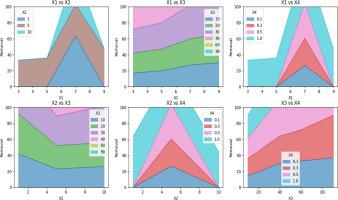Machine learning-based prediction and optimization of effective removal of tetracycline from wastewater using magnetic MoS2/polyglucosamine/β-cyclodextrin nanocomposite
IF 6.3
3区 工程技术
Q1 ENGINEERING, CHEMICAL
Journal of the Taiwan Institute of Chemical Engineers
Pub Date : 2025-07-30
DOI:10.1016/j.jtice.2025.106315
引用次数: 0
Abstract
Background
The growing amount of tetracycline (TC) antibiotics in wastewater has given a warrant to major response due to the need of efficient removal strategies, which this research presents on the application of a magnetic MoS2 /polyglucosamine/ β_cyclodextrin (MPCN) composite nanocomposite as a quick and effective adsorption agent TC, and model the process via machine-learning sequence modelling.
Methods
It based the model formulation on two machine learning algorithms Lasso Regression (LR) and Polynomial Regression (PR) in predicting removal efficiency, using all essential key operational parameters to include pH (X1), initial TC concentration (X2), contact time (X3), and adsorbent dosage (X4). Particle Swarm Optimization (PSO) optimized work conditions (pH = 7, concentration = 1 mg L−1, contact time = 90 min, dosage = 1 g L−1) to improve model performance and accuracy.
Significant Findings
Maximum removal efficiency reached 94.7 %. The high performance of the multinomial regression model on the training data was clearly evident. Consequently, with regard to the training data, the model fitted very well and as a result R2 and MAE were 0.91 and 2.85 % respectively. In addition, the high overfitting of the test data compared to the training data with an RMSE value of 6.23 % was a strong reason that the model performed much better on the training data. LR training accuracy was higher than PR in generalization (R2 = 0.85, MAE = 3.42 %), and RMSE was lower by 18.3 % across the models. PSO had an improved accuracy (Average Error Reduction) when it came to modeling in practical application as compared to PR and LR.

磁性二硫化钼/聚葡萄糖胺/β-环糊精纳米复合材料对废水中四环素有效去除的机器学习预测与优化
随着废水中四环素(TC)抗生素的不断增加,对高效去除策略的需求日益迫切,本研究提出了一种磁性MoS2 /聚葡萄糖胺/ β_cyclodextrin (MPCN)复合纳米复合材料作为快速有效的四环素吸附剂的应用,并通过机器学习序列建模对该过程进行建模。方法利用pH (X1)、TC初始浓度(X2)、接触时间(X3)、吸附剂用量(X4)等关键操作参数,基于Lasso回归(LR)和多项式回归(PR)两种机器学习算法建立模型,预测吸附效率。粒子群优化(PSO)优化了工作条件(pH = 7,浓度= 1 mg L−1,接触时间= 90 min,剂量= 1 g L−1),以提高模型的性能和准确性。显著结果:最高去除率达94.7%。多项回归模型在训练数据上的高性能是显而易见的。因此,对于训练数据,模型拟合得很好,R2和MAE分别为0.91和2.85%。此外,与训练数据相比,测试数据的高度过拟合(RMSE值为6.23%)是模型在训练数据上表现更好的一个重要原因。在泛化方面,LR训练准确率高于PR (R2 = 0.85, MAE = 3.42%),各模型的RMSE低18.3%。与PR和LR相比,PSO在实际应用中具有更高的建模精度(平均误差减少)。
本文章由计算机程序翻译,如有差异,请以英文原文为准。
求助全文
约1分钟内获得全文
求助全文
来源期刊
CiteScore
9.10
自引率
14.00%
发文量
362
审稿时长
35 days
期刊介绍:
Journal of the Taiwan Institute of Chemical Engineers (formerly known as Journal of the Chinese Institute of Chemical Engineers) publishes original works, from fundamental principles to practical applications, in the broad field of chemical engineering with special focus on three aspects: Chemical and Biomolecular Science and Technology, Energy and Environmental Science and Technology, and Materials Science and Technology. Authors should choose for their manuscript an appropriate aspect section and a few related classifications when submitting to the journal online.

 求助内容:
求助内容: 应助结果提醒方式:
应助结果提醒方式:


